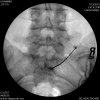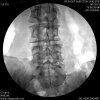- Joined
- Feb 2, 2008
- Messages
- 2,334
- Reaction score
- 793
I have two patients right now that I am contemplating RFA for and I'd like to hear if anyone else has had success with these issues with RFA.
One patient has a sacralization of L5 and you can clearly see on her imaging where the oversized TP of L5 (only on one side) connects with the sacrum and SIJ. I blocked that articluation (high up at the transitional artic. not low as with standard SIJ) and she got wonderful but temp relief. Then I did a standard SIJ inject w/o psis and she got less relief. I'm thinking about RFA for longer lasting relief. Thoughts/details with prior success? Heard of surgery for this?
Pt #2 is in her 30s and has has back pain since teens. Clear as day pars defects at L4-5 B/L. Has even formed joint capsules at the defects. Stable on F/E XRs. Saw outside pain doc and surgeon. Pain doc did did facet injs (not pars) which did not help. Surgeon said "come back when you are crawling in pain". She has a lot of pain alreasy and grits it out working full time. I did pars inj's and was even able to aspirate some fluid (no it wasn't csf) from each. Superb relief but I'm guessing it will be short lived. RFA for this or just find a diff. surgeon?
Cheers
One patient has a sacralization of L5 and you can clearly see on her imaging where the oversized TP of L5 (only on one side) connects with the sacrum and SIJ. I blocked that articluation (high up at the transitional artic. not low as with standard SIJ) and she got wonderful but temp relief. Then I did a standard SIJ inject w/o psis and she got less relief. I'm thinking about RFA for longer lasting relief. Thoughts/details with prior success? Heard of surgery for this?
Pt #2 is in her 30s and has has back pain since teens. Clear as day pars defects at L4-5 B/L. Has even formed joint capsules at the defects. Stable on F/E XRs. Saw outside pain doc and surgeon. Pain doc did did facet injs (not pars) which did not help. Surgeon said "come back when you are crawling in pain". She has a lot of pain alreasy and grits it out working full time. I did pars inj's and was even able to aspirate some fluid (no it wasn't csf) from each. Superb relief but I'm guessing it will be short lived. RFA for this or just find a diff. surgeon?
Cheers



